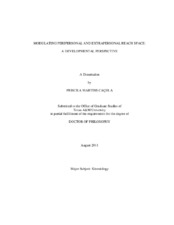| dc.description.abstract | The primary intent of this study was to gain insight into the developmental nature of spatial perception and representation. More specifically, the work presented here examined 1) the age-related ability to modulate peri- and extrapersonal space via hand and tool use, 2) the adjustment period associated with extending and retracting spaces, and 3) the effect of tool length on modulation of space. Seventy children representing age groups 7-, 9-, 11 years and adults were presented with two experiments using an estimation of reach paradigm involving hand and tool conditions and a switch-block of the opposite condition. Experiment 1 tested Hand and Tool (20cm length) estimation and found a significant effect for Age, Space, and an Age x Space interaction (ps <.05). Both children and adults were less accurate in extrapersonal space, indicating an overestimation bias. Interestingly, the adjustment period during the switch-block condition was immediate and similar across age. Experiment 2 was similar to Experiment 1 with the exception of using a 40cm length tool. Results of 55 participants also revealed a difference in estimation responses between Age groups (p <.05); 7- and 9-year-olds were similar and less accurate than adults, and 11-year-olds were not different from any other age group. There was also a difference in Space (p <.05), revealing that participants underestimated their reaching abilities with higher accuracy in extrapersonal space. Interestingly, whereas participants overall overestimated with the 20cm tool, they tended to underestimate while using the 40cm tool. This finding suggests that participants were less confident when presented with a longer tool, even though the adjustment period with both tool lengths was similar. Considered together, these results hint that: (1) children as young as 6 years of age are capable of re-scaling peripersonal space via tool use in the context of estimation reach, (2) the adjustment period associated with extending and retracting spaces is immediate rather than gradual, and (3) tool length may influence confidence of participants, shifting the general direction of error from overestimation with a 20cm tool to underestimation with a 40cm tool. | en |


